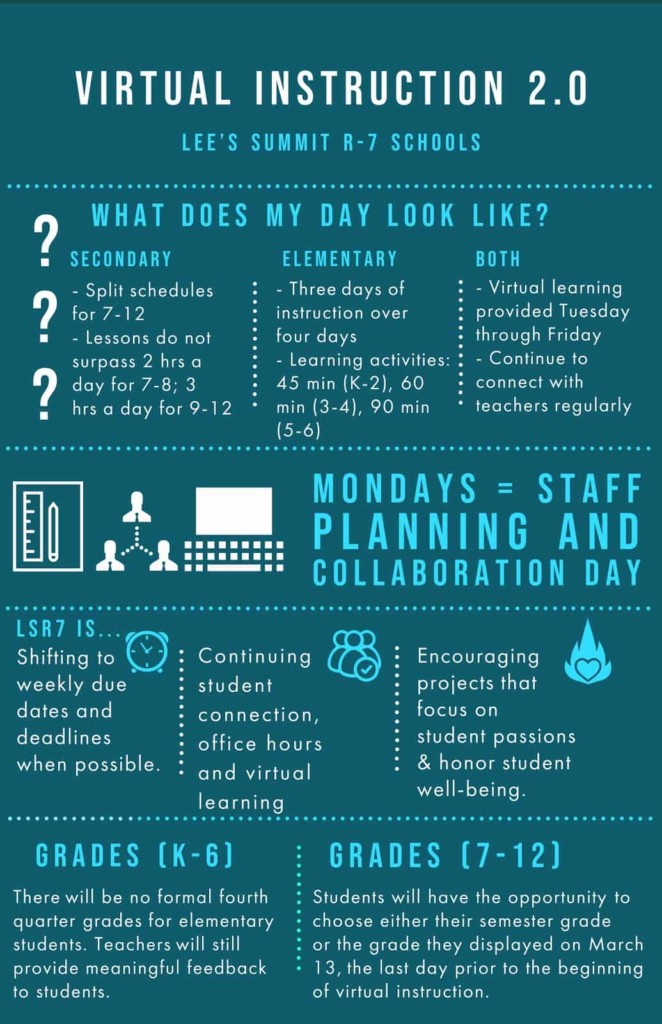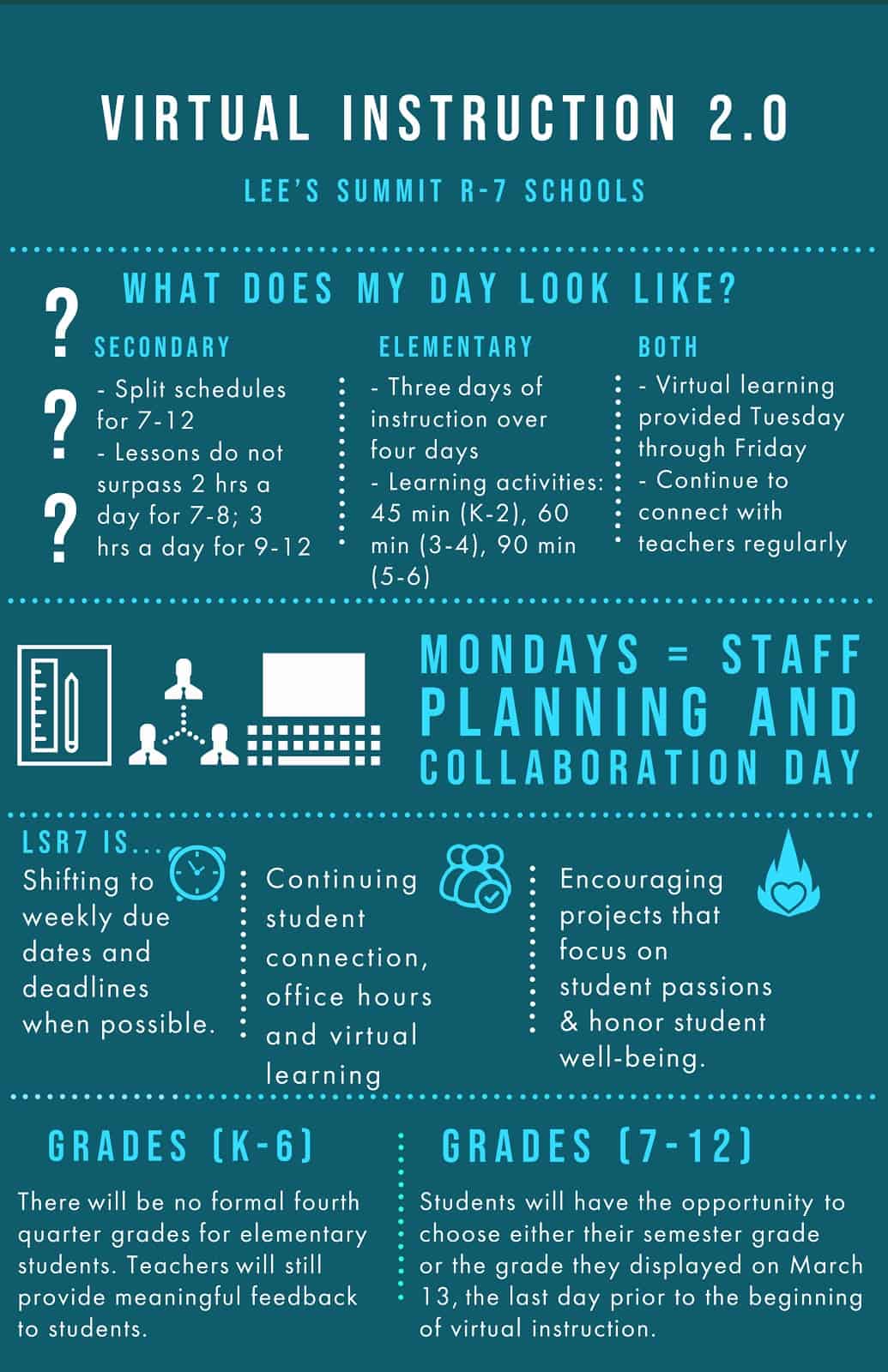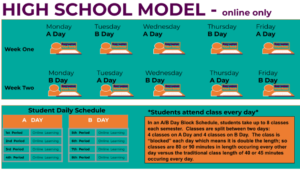Connections Matter in Lee’s Summit: Planning and Adapting to Virtual Learning

By: Jennifer Kephart
As our district began to hear the news of the potential school closures we started shifting our mental models to the care and connection we needed to have with our students and staff through the impending uncertain, uncharted time.
As district leaders, we did what we do best and we met. We talked and we planned and we wrestled and we settled into a groove of asking questions and providing answers we thought others would need. We rolled out our first plan with phases of closure.
Then we learned, and we went back to the war room to focus more deeply and differently. And we rolled out our second plan with a focus on two weeks of virtual instruction.
Then we learned, and we went back to the focus on the daily struggles of our students, families, and staff. And we rolled out our third plan with the key foundation of less being more.
Through all of our planning and collaboration, the heart of who we are and what we believe about our passions for students was apparent: We wanted to connect with our students and staff to ensure they had what they needed to successfully stay united in this time. Our mission was clear:
As we continue in uncharted waters, it is our goal to support the seamless acquisition of learning through cognitive engagement opportunities for our students while caring for your needs and those of your students and families. During this time, we want to remember to breathe, to extend patience and to provide unwavering grace, understanding that everyone is trying their best to navigate the choppy waters of our present situation.
Our focus remains steadfast on the social, emotional and holistic needs of R7 students and staff- your leadership provides that connection and care!
Now that we start to breathe and support the daily collaboration and learning, I, as the Associate Superintendent for Academic Services for an 18,000 student, 4,000 staff suburban school district, can start to see the power in our mission and messaging during this extreme shift in learning. I can also see the growth we still have and yet, the progress we have already made for the transformation of learning to come.
This is our journey, and while similar to many at this time, our core belief remains our connection to staff and to students. A connection that will, with grace and patience, take us into changed classrooms next fall.
The Weighty Decision
Before I can share our plans, I must share my heart. In the quiet of the early morning and the late evenings in between our dash to complete our instruction plans and prepare the questions for closure, the weight of our decision to close school was heavy.
As a former elementary teacher, elementary principal and mother of a 2020 high school graduate, I knew our decision to close would not be ours to make, yet one that would forever change the trajectory of our students- in the ways of resilience and in the ways of increasing trauma.
It was the weight of our students whose love, care, food, structure, and basic needs are met in our schools. It was the knowledge that we were sending some kids home into already strained family relations and students whose specialized care is placed in our adults every day. It was an increase in addictive behaviors and an increase in isolation for those contemplating suicide. It was the weight of our teaching staff whose daily contribution is rooted in being a teacher, building relationships and seeing students every day.
For me, those thoughts had to rest in my heart because they propelled our decisions to focus on connections over content and to have weekly calls with staff to show care and support. I knew our plans had to have a foundation on that care and a focus on access for all. We had to communicate and model grace and patience for our building leaders, our teachers, our students and our families.
Our Plans and Adaptations
It is amazing how quickly time moved in March with planning our Pandemic Instructional Procedures. In our district, we had been transitioning our teachers and classrooms to full implementation of a robust Schoology platform in order to provide a district aligned Learning Management System and support AMI (Alternative Methods of Instruction) for snow days next year throughout the state education department.
While we had about 80% of our teachers transitioned to Schoology, COVID-19 threw our plans and our staff into overdrive. As we planned, it was all hands on deck from our instructional team, our technology team and our various instructional specialists keeping the focus on how we connect ALL of our students and ensure they are able to continue to access technology during this time.
In our first instructional plan, we asked building leaders to Focus on Connection, Communication, Needs and Support for staff and families. We wanted to provide structured autonomy for our leaders to build on to include their unique culture and climate with a foundation for virtual learning. Instructionally we guided learning to a core of 10-30 minutes per day/ per content with a focus of quality over quantity.
We asked teachers to avoid busy work and/or “free time” activities. We asked that teachers design lessons focused on the continuation of current scope and sequence of learning while remembering that some students may have data limits. We asked for daily check-ins and clearly defined deadlines around the acquisition of learning, as measured around grace and patience during our initial time of closure. We worked as a district to provide meals to families and connect with individual students through counseling, behavior support, EL support, and special education teletherapy.
- Focus on Connection: How do you connect with your school community? What plans do you have to connect with each staff member? How will staff members stay connected to students?
- As an administrative team, please make plans to make personal contact with each staff member weekly. This provides a touchpoint to see how they are doing and how they have connected with students.
- Focus on Communication: How will you continue to communicate with your staff and your families during this time?
- Please plan to continue a weekly newsletter with school highlights, district support, new information and a little levity.
- Focus on Needs: How do you ensure needs are being met for your families?
- After connecting with staff members, plan weekly touch base meetings with your administrative team- admin, counselors, ed therapist. Etc. – to see what resources need to be provided to students and staff.
- Focus on Support: How can you continue to support instruction as it is without undue expectations for teachers? How can you support a level of high expectations with a high measure of grace and understanding that teachers are each in a different spot?
- Please plan to review Schoology sites from teachers for your instructional leadership understanding and knowledge.
Teachers were planning and collaborating like never before over spring break and on our first virtual learning planning day upon our return. We had teachers learning from each other, creating virtual lessons, and supporting our changing landscape above and beyond anything we could have asked. Our teachers’ mindset fostered empathic disposition towards connection and change. They planned virtual meetings, staff spirit weeks, kick-off social distancing parades and ways to “see” their kids on day one.
On Day One we had tears of joy from students and teachers that used Schoology Conferences to ease the fear in a change of normalcy. But, we also had frustration as we realized all the connections were straining our system or those of our families to be on calls at the same time or use high levels of data and bandwidth. In an effort to provide access to all we rushed to order more hotspots and connect with every family. We pivoted at the end of Week One to decrease uploads/downloads and reminded teachers of the importance of asynchronous teaching. All in all, we made it- Week One was a success.
Then Week Two hit us and the strain of our national crisis on our families and learning platform became apparent. At this point, we were no longer looking at a two-week closure but extended through the month and we needed to adapt for the stress of our staff, students and system. We wanted to ensure wifi access for all families- which we were 81 short- awaiting a shipment of additional hotspots. We also wanted to ensure that our families and students were not overwhelmed and overburdened by assignments during a stressful and difficult time.
Our next adaptation included the addition of a Monday teacher planning day to support collaboration and student feedback. We also moved the utilization of a secondary staggered/split schedule, adjusted limits for the amount of time students should be spending on learning, deemphasized formal attendance checks and shifted toward extended due dates in order to make the virtual workload more manageable for students. At the forefront was the continued goal of connection to improve our instructional delivery for students.

Our New Landscape
Our focus remains steadfast on the social, emotional and holistic needs of students while reinforcing core knowledge. As an instructional leader, I know this time will bring us closer to our goals of Real World Learning. As a district, we are expanding opportunities for our students throughout our system by engaging students in elementary exploration, igniting passions in middle school and providing experiences to students in high school that support student workforce development and career readiness.
Our uncharted waters are already helping teachers engage in developing learning experiences differently. From this monumental shift, I am hopeful we will be further along our path of a teaching plan for instruction in design thinking strategies for authentic work experiences. We are continuing to learn, continuing to strive for access and opportunity for all students, and continuing to pave the way for students to see school as a place of connection and engagement.
That is the heaviness that sits with me now; are we ready for this to be our monumental shift? Is this our transformation? And how, now, do I best lead and support our transformation from this place of connection?
For more, see:
- The Kansas City Area Real World Learning Initiative and Recognizing the Need for Change
- Kansas City High Schools Add Real-World Learning
- Getting Through: Leading Through And To A New Generation Of Learning Systems
Stay in-the-know with innovations in learning by signing up for the weekly Smart Update.
Dr. Jennifer Kephart is currently the Associate Superintendent of Academic Services in the Lee’s Summit School District. Dr. Kephart supports the district’s goal of growth while empowering district leaders to develop deep learning and transformation across the education system to ensure all students are best equipped with a foundation to be future-ready.






0 Comments
Leave a Comment
Your email address will not be published. All fields are required.